A Complete Symbiosis TX Guide to Pond Design, Construction, and Ecological Stewardship
Ponds are transforming properties across Central Texas. As weather patterns swing between intense drought and heavy rain, landowners are seeking reliable, ecological ways to store water, increase biodiversity, and cool the landscape. At **Symbiosis TX**, we specialize in designing and building ponds that work with nature rather than against it. This guide walks you through the essential principles of creating a durable, regenerative pond system in our unique region.
Whether you are restoring a failing pond or planning your first livestock tank, this article provides everything you need to know before breaking ground.
Why Pond Design Matters in Central Texas
Central Texas is a region shaped by shallow soils, fractured limestone bedrock, high evaporation rates, and sudden, storm driven rainfall patterns. These environmental factors make pond building uniquely challenging, and they demand thoughtful planning and design. A poorly sited or improperly sealed pond can become a long term liability, wasting time, money, and ecological potential. But when a pond is designed correctly from the start, it becomes one of the most valuable features on the landscape. It can support wildlife, moderate temperature extremes, enhance soil moisture, and provide lasting resilience during drought.
A well built pond does more than store water. It creates a microclimate, supports native plants and animals, invites beneficial insects and amphibians, and acts as a stabilizing force within the broader watershed. Done right, it becomes a living system that strengthens the health of the land around it rather than simply occupying space.
This guide follows Symbiosis TX best practices and draws on lessons learned from real Central Texas projects. Our approach blends practical earthworks experience with ecological design principles to help landowners create ponds that are beautiful, functional, and durable in our challenging climate.
Table of Contents
Evaluate Your Catchment Area
The Most Important Step in Pond Planning
A pond cannot fill itself. It depends entirely on the watershed that drains into it during rainfall. The standard rule of thumb is that one acre of pond requires roughly fifty acres of contributing land, though this can vary depending on slope, soil type, vegetation cover, and rainfall intensity.
Understanding whether your property meets this requirement takes more than a quick visual assessment. Water does not always move the way we assume it does. Slight changes in elevation, subtle ridgelines, and shallow depressions can dramatically influence how runoff flows across the landscape. What appears to be the “obvious” catchment may in reality drain in another direction entirely.
To get an accurate picture, you need to evaluate the land using contour maps, high resolution elevation data, or Google Earth Pro. Mapping the slope and natural flow paths reveals where water converges, where it spreads thin, and where it bypasses your potential pond site altogether. This step is essential because a pond built in the wrong spot will struggle to fill no matter how well it is designed.
If your watershed is too small or too shallow, no amount of compaction, sealing, or bentonite will compensate for inadequate inflow. A beautifully engineered pond with insufficient contributing acreage simply becomes an expensive dry hole.
By contrast, a well-positioned pond with a healthy catchment can fill consistently, recharge more dependably, and maintain water levels even through long Central Texas dry spells. Larger contributing areas also buffer against the unpredictable nature of Texas rainfall, where long dry periods are often followed by short, intense storm events. When your watershed is sized correctly, even moderate rains can add meaningful volume to the pond.
Accurately understanding your watershed is one of the most important steps in successful pond design. It sets the foundation for everything else that follows — from sizing and depth decisions to liner choice, spillway design, and long term ecological performance.
Need help mapping your watershed?
Understand Your Soil Profile

Sandy Loam, Limestone, and What It Means for Pond Sealing
Most Central Texas soils contain a mix of sandy loam over fractured limestone. Sandy soils allow seepage, while limestone formations often create pathways for underground leaks. Because of this, conducting proper soil testing is essential before deciding how to seal your pond.
When you dig test pits or use a soil auger, you are looking for indicators such as natural clay layers, sandy loam, rock fragments, fractured limestone shelves, or expansive clays. If you uncover consistent clay at depth, proper compaction may be all you need. If the profile shows sandy or rocky layers instead, a sealing strategy like bentonite clay will be required.
If you want to learn more about how to conduct a basic soil test, check out the helpful guide from Take Care of Texas:
https://takecareoftexas.org/about-us/blog/soil-testing-three-easy-steps
Liner Options: Bentonite vs EPDM vs HDPE
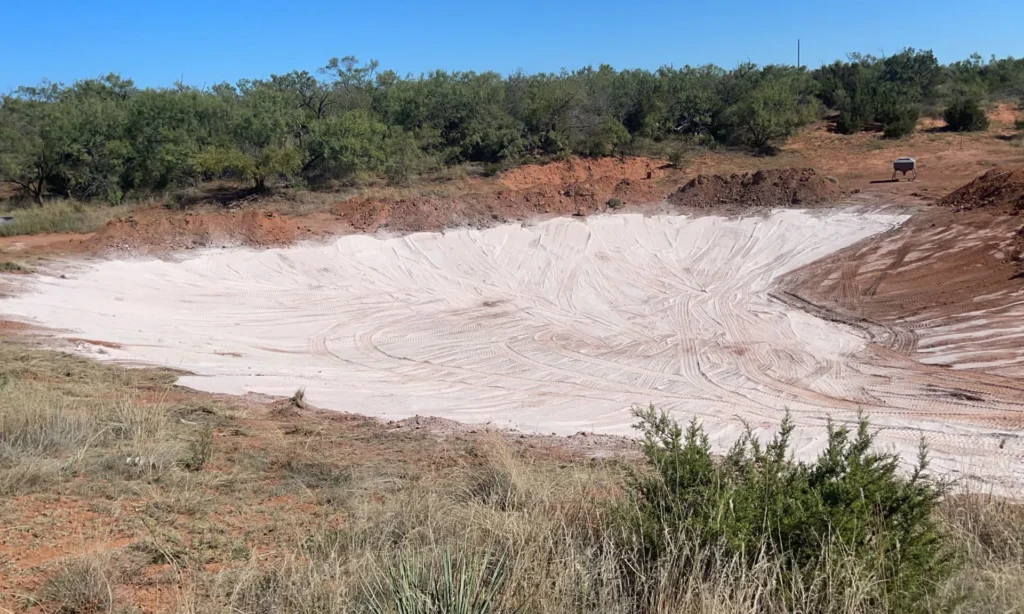
Bentonite is a naturally occurring swelling clay that expands significantly when hydrated, forming a dense, gel-like barrier. Unlike synthetic liners, bentonite blends directly into the native soil, creating a semi permeable seal that reduces seepage while still allowing some groundwater exchange. This interaction between soil and water helps maintain a more stable, biologically rich pond ecosystem.
Because bentonite is applied as a loose material and worked into the soil, it is far easier to install at scale than petroleum based liners. It does not require specialized welding crews, expensive seam equipment, or the careful handling that synthetic liners demand. Once hydrated and compacted, bentonite forms a flexible seal that can self-heal minor cracks caused by soil movement or root intrusion. This makes it ideal for regions with shifting soils or landscapes with natural subsurface complexity.
Cost is another major advantage. For large ponds, stock tanks, or landscape water features, bentonite is significantly more affordable than EPDM or HDPE. The material cost scales more naturally with acreage, making it accessible for landowners who want a functional pond without the high price of industrial liners.
Most importantly, bentonite supports ecological pond design. Since it creates a semi permeable seal rather than a hard barrier, water can continue interacting with the surrounding soil. This promotes beneficial microbial activity, healthier riparian plant growth, moderated temperature swings, and a more natural, stable water body overall.
For sandy or sandy loam soils, we typically recommend applying 4 to 5 pounds per square foot. This amount provides a reliable seal while accommodating the higher permeability of Central Texas soil profiles. In sites with more native clay or lower permeability, the application rate may be reduced, but in highly porous or rocky areas, additional material may be needed to ensure long term performance.
Petroleum Based Liners:

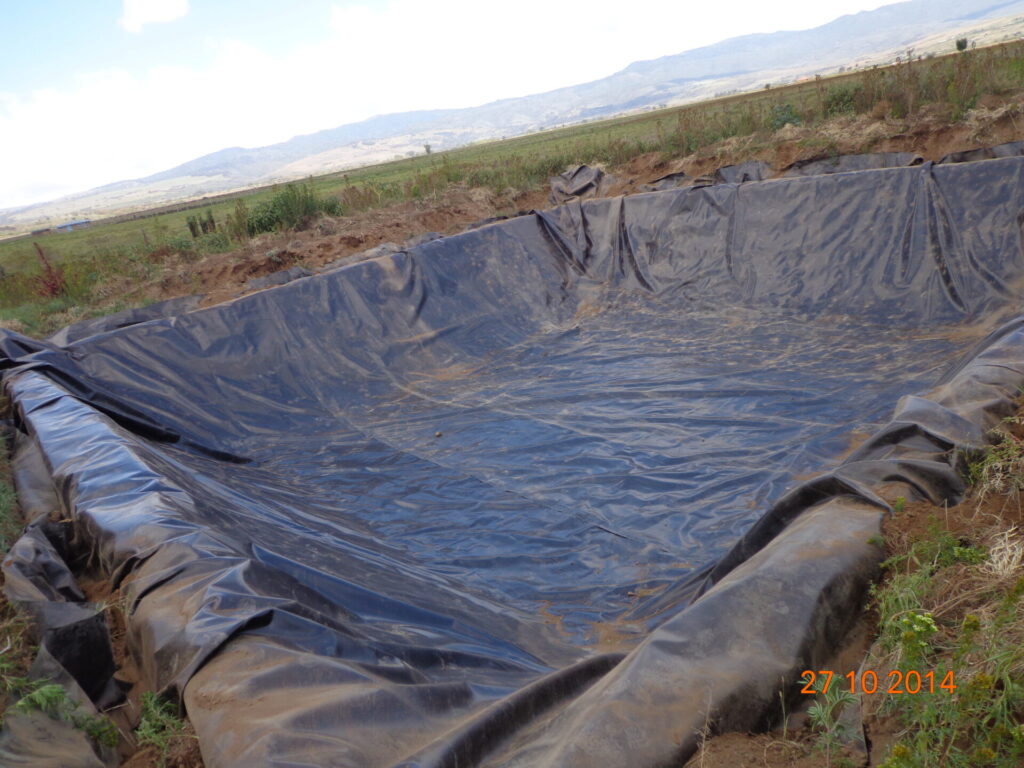
These petroleum based liners provide a fully impermeable seal, which may sound ideal at first, but they come with several important drawbacks. EPDM and HDPE liners are expensive to purchase, heavy to transport, and often require professional crews trained in specialized welding or seaming techniques. Even a small mistake during installation can create weak points that eventually tear or fail under pressure.
In smaller contexts, though, these liners have their place. Backyard water features, koi ponds, small garden ponds, or decorative 200 to 300 gallon installations benefit from an impermeable membrane. The scale is small enough that the material cost is manageable, seams can be handled safely, and the installation does not require heavy equipment. In these settings, a synthetic liner provides a predictable, clean, and low-maintenance solution.
The challenge arises when property owners try to scale this approach to full sized stock ponds, retention basins, or large landscape water features. At that scale, EPDM or HDPE liners become cost prohibitive, difficult to maneuver, and risky to install correctly. More importantly, they do not align with the goals of ecological pond design. Because they completely isolate water from the surrounding soil, they prevent natural hydrological exchange, reduce beneficial microbial activity, eliminate subtle groundwater recharge, and create a more artificial aquatic environment.
For landowners interested in regenerative water systems that interact with the landscape, support natural biodiversity, and function as part of a larger watershed, these impermeable liners often become a limitation rather than an asset. In those cases, a natural sealing approach such as bentonite is usually far more appropriate.
Pond Depth and Shape
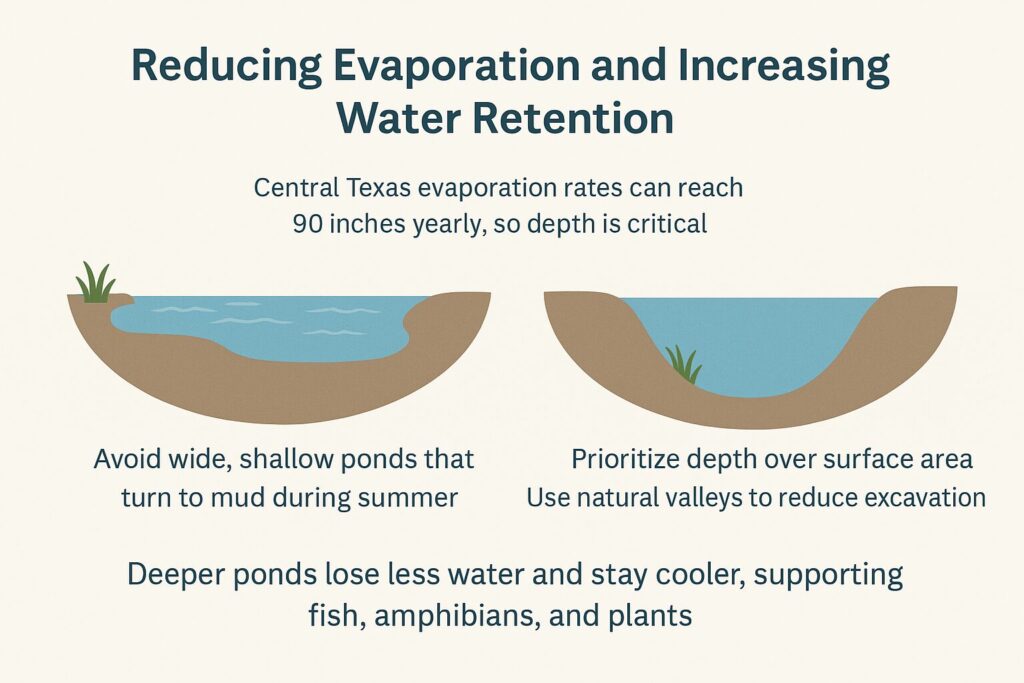
Reducing Evaporation and Increasing Water Retention
In Central Texas, evaporation is one of the biggest factors influencing pond performance. With annual losses reaching up to 90 inches, a pond must be designed to minimize exposed surface area and maximize depth to hold water reliably. Shallow, wide ponds lose water rapidly as wind, heat, and sunlight increase evaporation, often leaving only mud during the peak of summer.
Depth is the single most effective tool for combating evaporation. Deeper ponds protect more of their volume from the elements, maintain cooler water temperatures, and create thermal refuge for fish, amphibians, and aquatic plants. Whenever possible, it is best to position a pond within a natural valley or low spot, which reduces the amount of excavation needed while producing a deeper basin with a smaller surface footprint.
Accessibility also plays an important role in shaping the pond. While deeper water helps conserve volume, the shoreline still needs to be approachable where people and animals interact with the pond. Designing at least one gently sloped access point makes it safer for livestock to drink, allows wildlife to enter and exit the water easily, and provides a comfortable place for people to interact with the pond without encountering steep or eroded edges. These intentional access zones should be balanced with steeper, erosion-resistant slopes elsewhere, maintaining depth for water retention while still supporting safe, functional use.
Side slope design influences all of these goals. Slopes between three to one and four to one strike the right balance between safety, stability, and evaporation control. This shape allows the pond to reach functional depths without creating excessive shoreline that increases water loss, while still offering space for controlled access points, plant establishment, and wildlife movement.
By intentionally designing for depth, using natural land contours, and planning both retention and accessibility, you greatly improve the pond’s ability to remain full and functional throughout the year. A well-designed deep pond not only persists through long hot spells, it also fosters a more stable, biologically rich, and user-friendly aquatic ecosystem.
Designing a Functional Spillway

Protecting the Dam Wall During Heavy Rain
A properly designed spillway is one of the most critical components of any pond in Central Texas. Without a safe, dedicated outlet for overflow, heavy rain can cause water to rush over the top of the dam wall, cutting into the soil, weakening the structure, and eventually creating a breach. Many pond failures in Texas can be traced directly to the absence of a functional spillway, even when everything else about the pond was built correctly.
A good spillway does more than simply move water. It must be wide enough to handle peak flow during major storm events, especially in regions with intense flash flooding. The spillway channel should be shaped and graded to guide water smoothly away from the dam, preventing side cutting and erosion. Armoring this channel with rock, vegetation, or both helps protect the soil, slows the flow, and increases long term durability.
Freeboard, the vertical distance between the water surface and the top of the dam, is another essential part of spillway design. Adequate freeboard ensures that even during sudden inflows, water exits through the spillway rather than overtopping the dam. These engineering details work together to preserve the integrity of the pond and keep the dam stable through extreme weather.
A well-built spillway is not optional. It is a foundational part of pond resilience, protecting your investment and ensuring the pond remains safe, functional, and long lasting.
For detailed technical standards and spillway design criteria, refer to the USDA NRCS Handbook 590 and Conservation Practice Standard 378. For Texas-specific pond management guidance, the Texas A&M AgriLife Extension Service offers an excellent practical overview.
Equipment Options for DIY or Contractor Builds
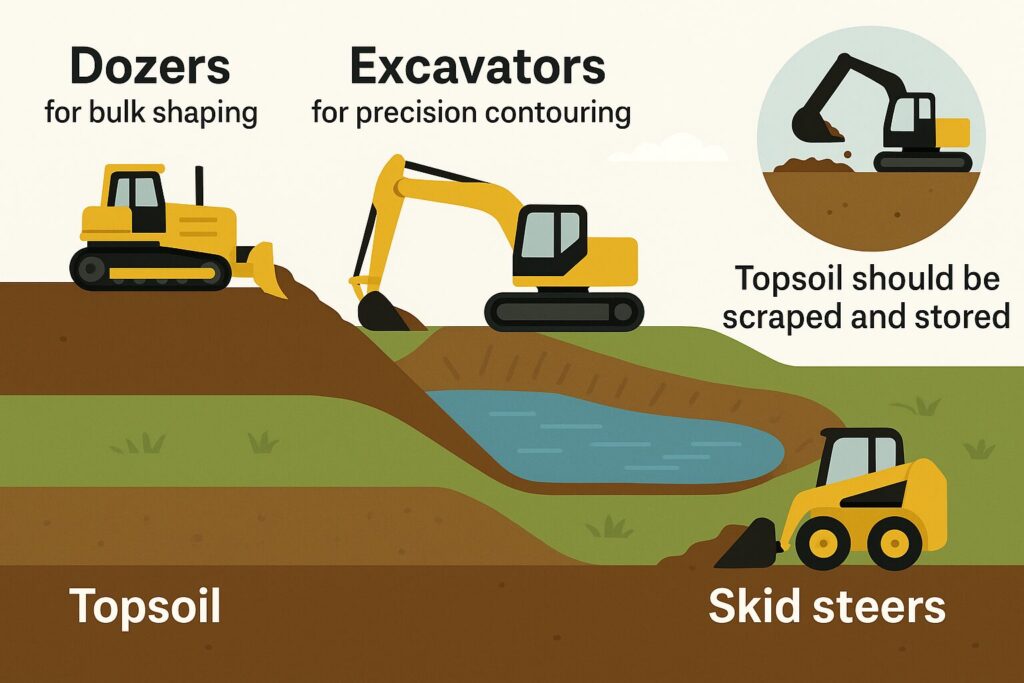
Excavators, Dozers, Skid Steers, and Best Combinations
Choosing the right equipment is a major factor in the efficiency, cost, and final quality of a pond project. Each type of machine excels at specific tasks, and understanding their strengths helps ensure your earthworks are shaped accurately and efficiently. Whether you are hiring a contractor or taking on a portion of the work yourself, matching equipment capability to your site conditions will save significant time, money, and rework.
Dozers are ideal for bulk earthmoving and rough shaping. With their broad blades and powerful traction, they can push large volumes of soil quickly and efficiently, especially across longer distances. A dozer is often the fastest tool for establishing the initial pond footprint, cutting keyways, and building or shaping the dam wall. However, fine detail work is more challenging with a dozer alone.
Excavators provide precision. Their ability to dig deep, reach vertically or horizontally, and remove material with control makes them essential for forming steep side slopes, establishing depth, cutting test pits, and handling rocky or uneven terrain. Excavators are also great for placing rocks, boulders, or bentonite in a controlled manner. For many pond projects, an excavator becomes the most versatile piece of equipment on site.
Skid steers shine in mobility and speed for short-distance soil movement. They are excellent for moving loose material, spreading topsoil, shaping smaller areas, and assisting in site cleanup once the major excavation is complete. A skid steer paired with an excavator is often the most cost-effective combination for small to medium-sized ponds.
Topsoil management is also vital. Before excavation begins, the topsoil layer should be scraped off and stored separately. This nutrient-rich material is later used to dress the dam wall, restore native vegetation, and stabilize disturbed areas. Preserving topsoil protects your long-term ecological goals and accelerates the recovery of plant life around the pond.
Combining equipment strategically ensures the work progresses smoothly. For example, an excavator can loosen and shape soil while a skid steer transports it to the dam wall, or a dozer can rough out the basin while an excavator finishes the precision cuts. Matching machine capabilities to project phases creates a more efficient workflow and results in a better-built pond.
Installing Bentonite
Steps to a Successful Natural Pond Seal
Installing bentonite correctly is essential for creating a natural, durable, and dependable pond seal. Bentonite works by swelling when it hydrates, forming a dense, gel-like layer that fills gaps, binds to soil particles, and reduces seepage. To get the best performance, the material has to be applied in a way that integrates it directly into the native soil profile rather than sitting loosely on top of it.
The process begins by shaping and compacting the subsoil so the surface beneath the liner is stable, smooth, and free of voids. Once the basin is properly formed, bentonite is spread evenly across the entire pond floor and sidewalls. Uniform coverage is essential, since thin spots or missed areas can become points of seepage later on. After the bentonite is in place, it is lightly hydrated so it begins to expand and bind to the surrounding soil.
Next, a six-inch layer of subsoil is placed over the bentonite. This overburden protects the clay from being displaced, anchors it into position, and provides the mass needed for proper compaction. The entire surface is then compacted with a roller, which presses the bentonite and soil layers together and activates the swelling and sealing properties of the clay.
When done correctly, this method blends bentonite with the native soil to create a long-lasting, semi permeable seal that mimics a natural clay liner. It is one of the most reliable and ecologically compatible ways to ensure a pond retains water in sandy, gravelly, or fractured limestone environments.
For a deeper visual walkthrough of pond construction, sealing and design in a Texas environment, check out our video:
Using Rock Armoring

Protecting Edges, Adding Habitat, and Managing Inflow
Strategic use of rock around the pond edge plays an important role in both ecological function and long term durability. Rock armoring strengthens shorelines where livestock, wildlife, or foot traffic could otherwise damage the soil or disturb the pond liner. By creating firm, stable edges, rock features act as a protective buffer that prevents hooves or erosion from breaching the pond seal, especially in areas where animals regularly come to drink.
Rocks also help manage inflow. When placed at the points where runoff enters the pond, they slow the velocity of incoming water, reducing the erosive force that can cut channels into the bank or disturb the bentonite seal. This moderation of flow not only protects the pond structure but also improves water clarity by allowing sediment to settle before it reaches deeper areas. Submerged rock ridges in particular can catch silt and organic matter, forming natural sediment traps that minimize turbidity.
Beyond their structural benefits, rock features significantly enhance habitat diversity. Crevices between stones provide shelter for amphibians, aquatic insects, and small fish. Rocks create microhabitats with varying moisture, shade, and temperature conditions—elements that attract wildlife and contribute to a richer ecological community. These same features also add visual interest to the pond, blending the constructed shoreline with the natural landscape in an aesthetically pleasing way.
Well-placed rock armoring transforms the pond from a simple water body into a resilient and inviting ecosystem, offering protection, stability, and habitat all at once.
Improving Water Quality With a Settling Basin
Preventing Sediment and Chemical Contamination
Sediment and contaminants carried in runoff can have a significant impact on a pond’s clarity, ecological balance, and long-term performance. If your watershed includes tilled agricultural fields, chemically treated pastures, or disturbed soils, a sediment forebay becomes an essential component of responsible pond design. This small settling basin captures incoming runoff before it reaches the main pond, allowing sediment, fertilizers, herbicides, and other particulates to drop out of suspension. By slowing the water and giving it a place to settle, the forebay reduces turbidity, prevents nutrient overload, and protects the pond from the long-term accumulation of silt.
In addition to physical filtration, many pond builders incorporate biological enhancement to improve water clarity and overall ecological function. Microbial additives help establish balanced microbial communities that break down organic matter, reduce odors, improve nutrient cycling, and support a healthier aquatic ecosystem. Teraganix offers a range of Effective Microorganism (EM) formulations designed for natural water enhancement. These products introduce diverse, beneficial microbes that work with the existing system rather than against it, making them a widely trusted option for regenerative pond management and biological water treatment.
We partner closely with Teraganix and use their microbial solutions extensively across our own Symbiosis TX projects. Their products have proven reliable, consistent, and highly effective in supporting long-term water health in Central Texas conditions.
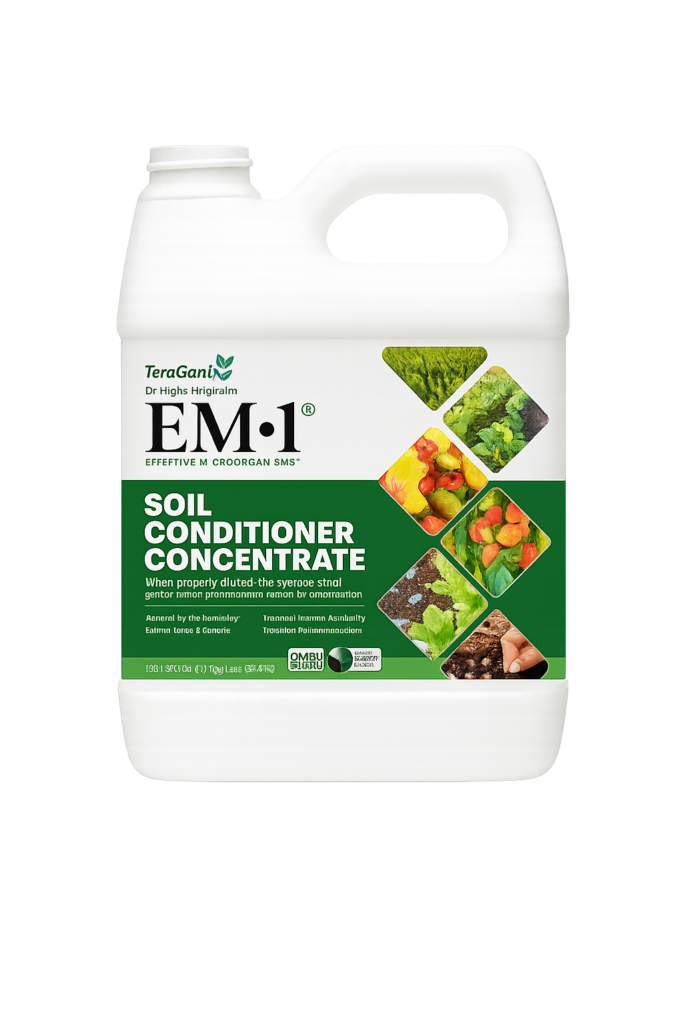
Teraganix Microbial Solutions for Clear, Healthy Pond Water
We rely on Teraganix microbial blends to enhance water clarity and support healthy pond ecosystems. Save 10% with code SYMBIOSISTX at checkout.
Revegetation and Riparian Planting
The Key to Long Term Pond Stability
Bare soil is highly vulnerable to erosion, especially after heavy earthworks. Establishing vegetation quickly is one of the most important steps you can take to protect your investment and ensure the long-term stability of the pond. After construction is complete, the dam wall and pond edges should be seeded and planted without delay so that roots can take hold before wind and rain begin to wear down the exposed soil.
For dam walls, species that establish quickly and have strong root structures are ideal. Brown top millet, native prairie grasses, and custom dam wall stabilizer mixes create a dense vegetative buffer that binds the soil together and prevents rilling or sloughing during heavy rains.
The edges of the pond benefit from species adapted to wetter, more variable conditions. Riparian seed mixes, wet-tolerant forbs, reeds, horsetail, hibiscus, vetiver, sedges, and native rushes all help stabilize the shoreline while creating habitat and improving water quality. Vegetation in this zone can filter runoff, trap sediment, and provide shade and shelter for amphibians, insects, and other wildlife.
A well-vegetated pond edge outcompetes invasive grasses like Bermuda and Johnson grass, reduces erosion, and enhances the ecological value of the entire pond system.
If you’d like to explore Central Texas–appropriate native plants for dam walls, riparian zones, or wetland edges, the Native Plant Society of Texas maintains a comprehensive searchable database. It’s an excellent resource for identifying species that match your soil, moisture, and sunlight conditions:
Planting Trees
Building Future Shade, Habitat, and Microclimates
Trees play a pivotal role in shaping the long-term character and ecological resilience of a pond environment. As they mature, they cast shade over the water, reduce temperature extremes, and create pockets of humidity that benefit wildlife and riparian vegetation. Trees also offer food, shelter, and structural diversity, transforming the pond from a simple water body into a dynamic habitat.
Some of the best species for Central Texas pond zones include Montezuma cypress, false indigo, elderberry, mulberry, and various native oaks. These trees thrive in the enhanced moisture near a pond while contributing to long-term soil health and wildlife habitat.
However, placement is critical. Trees should never be planted directly on the dam wall. Their roots can penetrate and weaken the structure, creating pathways for water to travel through and eventually undermining the integrity of the pond. Planting trees outside the dam footprint ensures stability while still offering all the ecological benefits of a diverse, well-planned canopy.
If you’d like help selecting tree species that match your soil type, moisture levels, and ecological goals, the Native Plant Society of Texas offers an excellent searchable plant database. It includes native trees suitable for riparian zones, upland areas, and transitional moisture conditions common around ponds:
The Leap of Faith
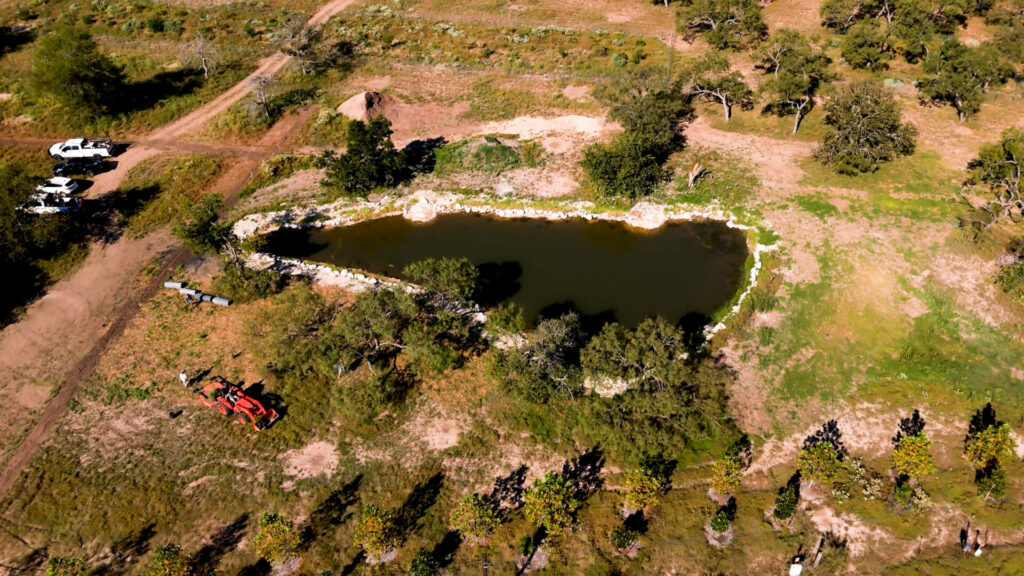
Working With Weather, Uncertainty, and Natural Systems
Even with thorough engineering and careful planning, building a pond means working with forces that remain partially outside our control. Weather can delay construction, saturate soils, or even partially fill a basin before the project is complete. Sudden storms may reshape flow paths or highlight design elements that need adjustment. No two ponds behave exactly alike, even when built with similar specifications.
This is part of the process. Building a pond is not only a technical effort but also a partnership with nature. The land will respond, the water will find its path, and the system will evolve over time. When you approach pond building with patience and adaptability, the end result can be incredibly rewarding—a resilient water feature that supports wildlife, enhances the landscape, and provides ecological value for decades.

Let’s Build a Water System That Supports Your Land for Decades.
A well-designed pond becomes a living part of your landscape, storing water, supporting wildlife, and creating long-term resilience. At Symbiosis TX, we design and install ponds that integrate seamlessly with your soil, watershed, and ecological goals.
Want a pond designed with intention, expertise, and environmental stewardship?

Building a Healthy Pond in Central Texas
Learn how to design, build, and maintain an ecologically functional pond in Central Texas. This comprehensive guide covers watershed planning, excavation, bentonite sealing, spillways, vegetation, microbes, and long-term ecological management.

Smart Weeding in Central Texas for Healthier Soil and Ecosystems
Weeding in Central Texas isn’t just about pulling unwanted plants. It’s a critical part of building healthier soils, supporting biodiversity, and cultivating resilient landscapes. In
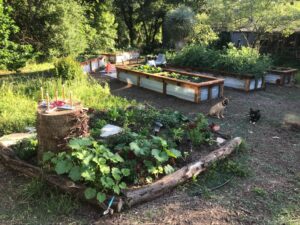
Complete Guide to Raised Garden Beds in Central Texas
Table of Contents Note: This menu is intended to provide our clients with brief descriptions and pictures of the raised bed options we install. Prices
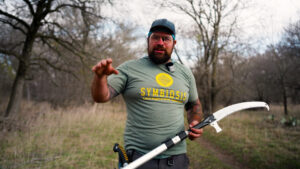
Seasonal Land Care in Central Texas: The Importance of Ecological Forestry in Winter
Ecoforestry is a sustainable land management approach that aligns forestry practices with ecological principles to maintain and restore healthy forest ecosystems. In Central Texas, timing forestry activities to coincide with seasonal conditions is crucial for promoting tree health and preventing diseases such as oak wilt. Conducting forestry work during winter and summer, when disease-spreading insects are less active, helps protect trees and supports biodiversity. Winter also offers advantages like cooler temperatures and better visibility due to leafless trees, making it an optimal time for tasks such as pruning, removing hazardous limbs, and improving land access. Implementing ecoforestry practices during these periods ensures the long-term health and resilience of Central Texas forests.
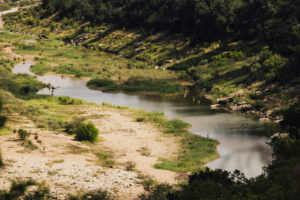
Texas Hill Country, The Rise, Fall, and Repair: Regenerative Agriculture in Texas
The connection between humans and the land is a cycle of both giving and taking—a relationship that shapes our lives every day and will continue
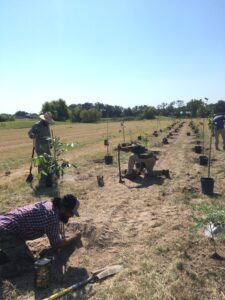
Planting 3,000 Trees: A Hopeful New Beginning in Texas
Our Client Named This Project Arborgasm In the heart of Texas, a former olive farm is getting a fresh start. This 78-acre piece of land,
